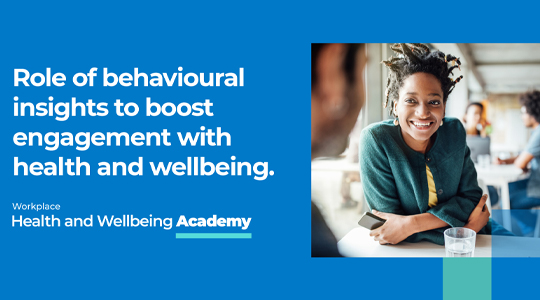How knowledge
can drive change
As humans, we’re largely irrational thinkers. 90-95% of our everyday behaviour is unconscious and driven by habits and mental shortcuts, yet there are predictable patterns in our irrationality.1 Behavioural insights is a transformative tool for change which sits in the sweet spot between theory, evidence and the real-world application of that knowledge — and it’s the key to unlocking targeted and cost-effective solutions to some of our biggest healthcare challenges.
Economist Richard H Thaler and Harvard Law School professor Cass A Sunstein, in the book Nudge: Improving Decisions About Health, Wealth and Happiness. explained, “By knowing how people think, we can make it easier for them to choose what is best for them, their families and society.”2 And this approach continues to transform change management and the way important messages are communicated.Insights deliver wins
Prime Minister David Cameron set up a Behavioural Insights Team — known as the ‘Nudge Unit’ — in 2010, and this has grown to a global social purpose company which has overseen more than 1,000 projects and over 700 randomised controlled trials.3
Behavioural insights play a key part in UK policy making and they have delivered big wins for public health. Missed NHS hospital appointments were cut by 25% by simply rewording SMS reminders to include the impact of no-shows4 — and at the start of the pandemic, the nation’s hand-hygiene was upgraded with a nudge to hum the Happy Birthday song.5
Dr Caroline Wood, Head of Behavioural Insights and Research at Bupa says:

"Behavioural Insights is a powerful tool in the workplace because it draws on the latest evidence and real-world data to develop solutions that can bring tangible improvement."
Addressing business challenges
Bupa understands the importance of behaviour change and has a dedicated team of behavioural scientists skilled in designing resources and interventions to address common corporate challenges around wellbeing, and engagement with benefits and services.
Caroline says, “It’s not enough simply to have policies and resources in place to support employee health and wellbeing. For the greatest gains, organisations also need to optimise engagement and take-up — and taking a behavioural approach does this.
Using theory to underpin solutions helps strengthen the rationale for any interventions and provides a roadmap to support agile iteration — which reduces time, uncertainty, costs and resources.”
The broad framework is universal, but implementation is tailored to individual businesses and challenges.
Case study: call centre call to action
The challenge: Improve employee engagement, reduce sickness, colleague attrition, and bolster customer service levels.
Define and discover: We analysed staff satisfaction surveys, exit interviews and desk research on workplace wellbeing to identify areas for improvement. These included fostering a closer sense of team cohesion and making opportunities for career development promotion more clearly understood.
Audit and advise: An audit of the office environment pinpointed several easy wellbeing wins such as improving access to natural light, and repainting the walls and introducing more office plants to create a calmer atmosphere.
Design and test: Is the point where this knowledge comes together — in this case interventions included provision of healthy snacks, standing desks and group exercises to improve wellbeing. Team names, and photos, were introduced to build cohesion, with rewards such as Pizza Friday for teams that hit targets. Greater focus was given to career and personal goals and additional development opportunities were advertised to staff.
Outcome: Turnover was down, absence reduced by 50% and Team Net Promoter Scores — a measure of customer experience— climbed to +71.
Case study from 2018Case study: promoting earlier help seeking for mental wellbeing
Caroline says, “Virgin Media came to us with concerns that their engineers on the road were at high risk of mental health issues. Bupa’s Healthy Minds gave staff and their families free 24/7 access to professional support for any problems — but the usage of this benefit was low.”
A review of the latest academic research identified several factors likely to influence usage. Of particular relevance for this group was the evidence that usage is typically lower when staff are mostly off-site, spread across multiple locations,6 are younger and predominately male.7
A scoping workshop with Virgin Media revealed a lack of awareness about Healthy Minds as well as hesitancy to engage with mental health unless issues reached a crisis point.
Caroline says, “Drawing on this insight, we co-designed a set of stickers, using messaging that resonated with men, to highlight the Healthy Minds hotline and placed them in engineer’s vans. This improved awareness of the benefit and nudged staff to call when they were unlikely to be disturbed. This was supported by tailored resources, such as top tips sheets to aid manager conversations."
Awareness of the Healthy Minds hotline rose across the workforce and, crucially, more staff were prepared to access the service.
Virgin Media case study from 2020Simple, effective solutions
Caroline says, “The strength of behavioural insights interventions is that they produce theory-based solutions which are often simple and inexpensive to implement.
It's often a matter of looking at insights and data that companies already have through a new lens. Bupa’s Behavioural Insights specialists can help your business use this lens to focus on key challenges and communicate the right interventions, at the right time, and the right place.”
For further information on working with Bupa's Behavioural Insights Team, please contact your Bupa Account Manager.

Watch the latest Bupa Behavioural Insights Academy module, bringing together the latest insights on how to boost employee engagement, with health and wellbeing services.
Visit the Bupa Academy for Workplace Health and Wellbeing page for more information.
1 Kahneman, D. (2011). Thinking, fast and slow. Farrar, Straus and Giroux.
3 https://www.bi.team/about-us/who-we-are/
4 https://www.bi.team/blogs/reducing-missed-appointments/
5 https://www.instituteforgovernment.org.uk/explainers/nudge-unit
6 https://www.ncbi.nlm.nih.gov/pmc/articles/PMC8064731/
7 https://journals.sagepub.com/doi/pdf/10.1177/1557988319857009 (PDF, 0.8 MB), https://eprints.leedsbeckett.ac.uk/id/eprint/1773/1/SAX_LitReview_MasculinityMentalHealth_Summary_FINAL.pdf (PDF, 1.9 MB)
Bupa health insurance is provided by Bupa Insurance Limited. Registered in England and Wales No. 3956433. Bupa Insurance Limited is authorised by the Prudential Regulation Authority and regulated by the Financial Conduct Authority and the Prudential Regulation Authority. Arranged and administered by Bupa Insurance Services Limited, which is authorised and regulated by the Financial Conduct Authority. Registered in England and Wales No. 3829851. Registered office: 1 Angel Court, London EC2R 7HJ
Bupa Health Trusts are administered by Bupa Insurance Services Limited. Registered in England and Wales No. 3829851. Registered office: 1 Angel Court, London EC2R 7HJ © Bupa 2025


